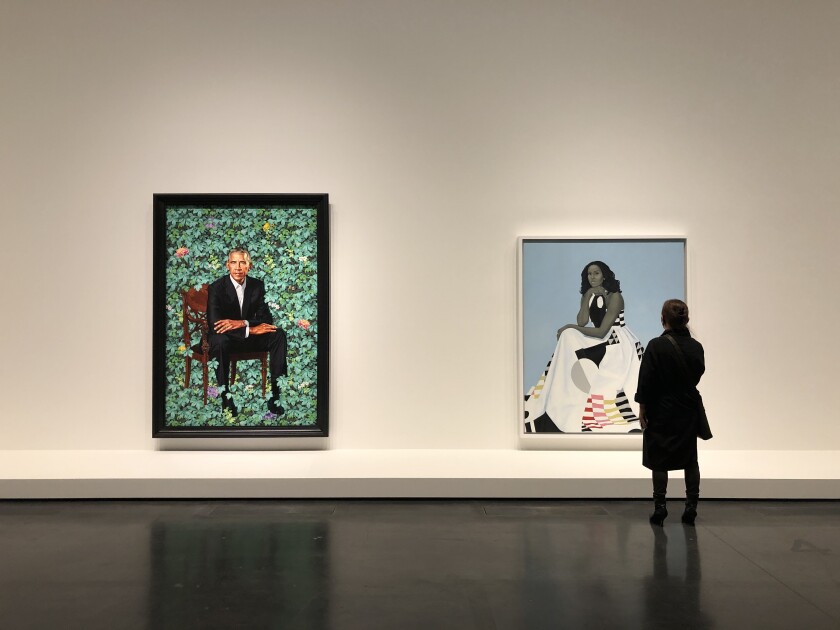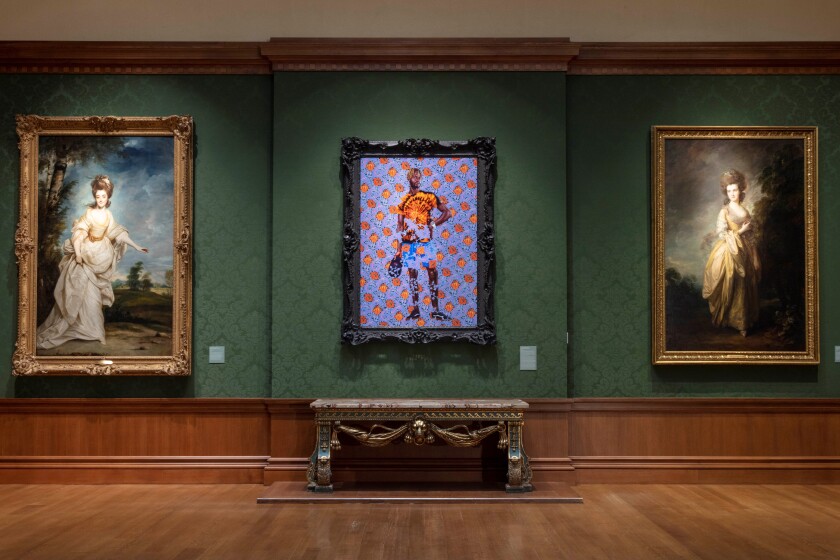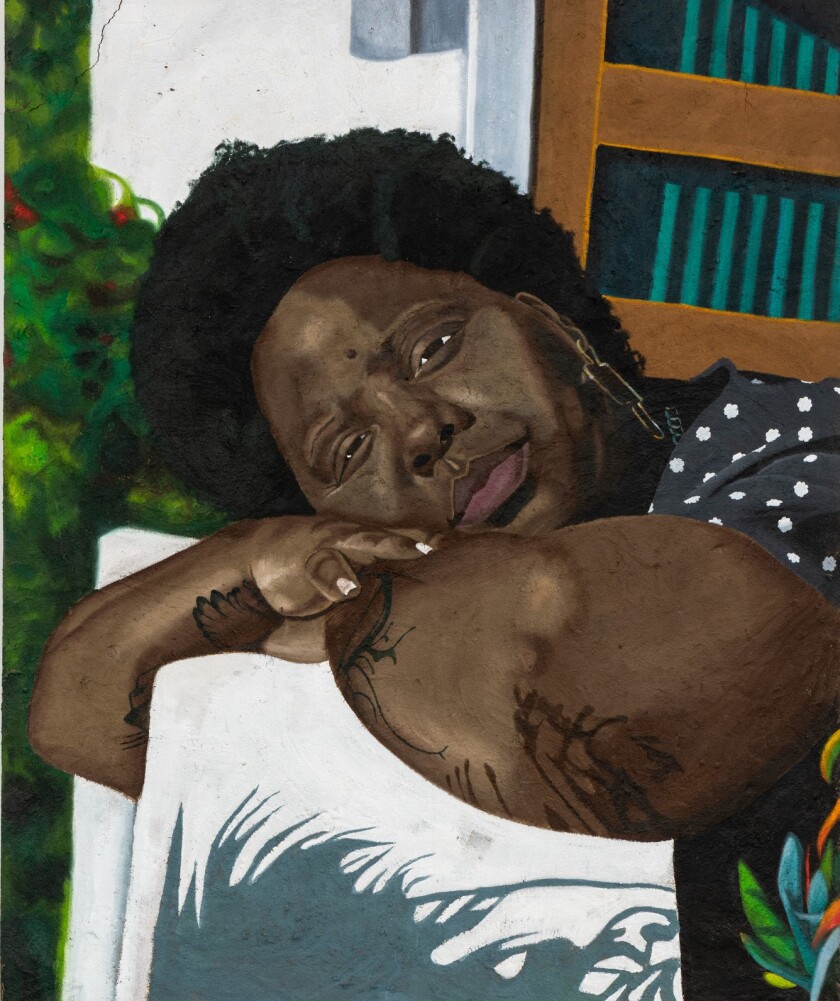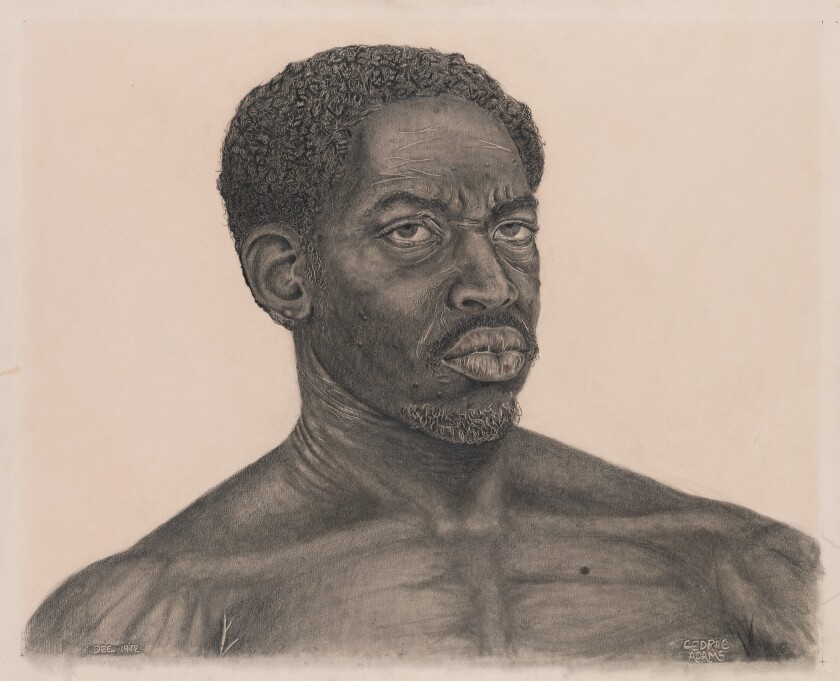Review: Obama portraits find good company in L.A. museum show that signals Black lives matter
Right now, more Black faces grace gallery walls and adorn display pedestals at the Los Angeles County Museum of Art than at any time in the museum’s 56-year history.
Maybe more than in all those years combined, but surely at least as many in a single show since 1976, when LACMA celebrated the nation’s bicentennial with the landmark “Two Centuries of Black American Art: 1750-1950.”
The stars are Barack and Michelle Obama, whose portraits were commissioned by the National Portrait Gallery in Washington, D.C., and unveiled to a warm critical reception in February 2018. Now embarked on a national tour to five cities, the paintings — respectively by Kehinde Wiley, 44, and Amy Sherald, 48 — open to the public in L.A. on Sunday. They occupy one wall of a large room, the empty space an indicator of an expectation for sizable crowds of eager viewers.
To give the two pictures some context, LACMA has also pulled together “Black American Portraits,” an exhibition in an adjacent gallery of 140 works by 110 artists, most but not all of them Black. Two-thirds are museum acquisitions and promised gifts, many recent, with the rest on loan from galleries and private collections. They’re hung salon-style, which yields a lively sense of visual conversation among disparate artists.
The Obama paintings, each figure shown seated and depicted roughly life-size, are stylistically different from each other, although both italicize aspects of the sitter’s personality.
Within a light-blue field, Sherald depicts the former first lady as a paragon of focused elegance. Her skin is gray, as in a black-and-white photograph, the artist’s frequent strategy for asking viewers of a painting to look beyond superficial assumptions about race.
Dressed in a long but unstuffy white evening gown, the geometric decorations on its billowing skirt a nod to designs in Modern art, African American quilts and current fashion, she rests her right elbow on her other forearm, draped over a crossed knee. Michelle Obama’s right hand languidly grazes beneath her chin, dangling blue fingernails that add a distinctive note of contemporary color.
The pose is at once self-protective, her body shielded, and exquisitely self-contained. The word that comes to mind is fierce. That admirable attitude is bold, unapologetic and intensely present — a perfect fit for the subject.

A spectator gazes at an installation of “The Obama Portraits Tour” inside the Resnick Pavilion at the Los Angeles County Museum of Art during a press preview Wednesday. The show opens to the general public Sunday and runs through Jan. 2, 2022. From left is Kehinde Wiley’s “Barack Obama,” 2018, and Amy Sherald’s “Michelle LaVaughn Robinson Obama,” 2018.
(Carolina A. Miranda / Los Angeles Times)
The former president is likewise casual, leaning forward in his chair and propped against arms crossed on his lap. He’s embedded, almost floating (see his shoes hovering above the ground plane), within an abundant topiary background. The hedge of greenery is artfully dotted with flowers not found together in nature.
Flowers are tributes long employed in art as nature’s ready symbols for culture’s elaboration on subject matter. Jasmine comes from Obama’s birthplace in Hawaii. African blue lilies identify Kenya, his father’s homeland. Chrysanthemums, the official flower of Chicago, where his public life began, are abundant. In this Edenic place, America’s first Black president is a New Adam.
A second, even more noteworthy feature of Wiley’s composition is Obama’s seated pose. He leans forward attentively in a wooden parlor chair, elaborately carved.
The pose recalls the composition of George P. A. Healy’s 1869 portrait of Abraham Lincoln, begun before the Civil War victor’s assassination but not finished until much later. (The painting now hangs in the White House.) Healy worked as tensions around Reconstruction rose and Congress passed the 15th Amendment — an attempt, still often futile, to stop Southern poll hostility by forbidding denial of voting rights on the basis of “race, color or previous condition of servitude.”
Lincoln subtly resonates within Wiley’s otherwise jubilant depiction of Obama. That historical layering, using an echo of past art in dialog with the present, is also a feature of Wiley’s marvelous recent commission from San Marino’s Huntington Library, Art Museum and Botanical Gardens, currently on view there.
His shrewd response to Thomas Gainsborough’s 1770 “The Blue Boy,” the museum’s famous signature painting, is to recast the scene with an unidentified young Black man, decked out in blue basketball shorts, trailing a baseball cap rather than a 17th century plumed cavalier hat, the clipped ends of his dreads bleached golden blond. Wiley’s lithe dandy stands amid a lavish network of royal blue acanthus leaves, classical symbol of immortality, and vivid orange poppies, modern British token of remembrance.

Kehinde Wiley’s “Portrait of a Young Gentleman” is a reimaging of Thomas Gainsborough’s “The Blue Boy” at the Huntington Library, Art Museum and Botanical Gardens.
(Joshua White)
Britain’s staggering wealth, memorialized in Gainsborough’s satin-draped adolescent aristocrat, was built on colonial exploits. For one, the nation’s burgeoning textile mills were fed by American cotton harvested on the free labor of a slave economy. The youth’s tie-dyed T-shirt, radiating from the very heart of Wiley’s reinvention, is an explosive whorl of orange color, spinning outward like a galactic “big bang.”
A new universe begins.
The brilliant precedent for Wiley’s fervent embrace of Euro-American painting traditions is the work of Kerry James Marshall. At LACMA, Marshall’s devastating little black-on-black “Portrait of the Artist as a Shadow of His Former Self” is at the entrance to “Black American Portraits.” A black man dressed in black and before a black background virtually disappears, save for his gap-toothed grin.
The painting, pivotal to his development and now a treasure in the museum’s collection (a promised gift of Steven and Deborah Lebowitz), turns Ralph Ellison’s epochal novel of Black identity, “The Invisible Man,” into a spur for self-invention. The history of European and American painting is as much a potent bequest for a Black American artist to harvest, Marshall smartly insisted, as the great traditions of Africa are.
Early American portraits of Black people are rare, but a marvelous image of a prosperous sailor, dated circa 1800 and acquired 15 years ago, hangs nearby. The unknown artist — most likely a white man, given the racial and gender limitations imposed around studio training — shows him framed by dark clouds dispersing into sunlight, a ship in a calm harbor in the distance. Notably, he’s dressed in red, white and blue.
Most everything else is from the 20th century, especially following the postwar civil rights movement, or from the 21st century, itself accounting for roughly half the show. A third are photographs, the stories of Black American lives coinciding with the mid-19th century invention and modern spread of the technology.
Oddly, LACMA’s collection has several hundred portraits of Black men, women and children by Robert Mapplethorpe, but none is included. Some have criticized Mapplethorpe, a white artist, as fetishizing Black sexuality, but the omission is puzzling. Why the skittishness?

rafa esparza, “big chillin with Patrisse,” 2021, acrylic on adobe, is in the LACMA exhibit.
(Ruben Diaz / Commonwealth and Council, Los Angeles)
Portraiture also gets loosely defined in the show — sometimes too loosely, as being anything with a figure in it.
Alison Saar’s 1996 “Sledge Hammer Mamma” delivers a mighty blow, turning the handle of the hefty demolition tool into a powerful female totem. Glenn Kaino inserts a golden upraised fist inside a mirrored box for his 2019 “Salute (Second Salute),” reflecting an image of resistance into infinity. Martine Syms’ 10-minute video loop, “Notes on Gesture,” from 2015 looks at how race and gender frame language and meaning. All are first-rate art, but none is a are portrait.
Ultimately the fudging doesn’t matter, though, as the sheer volume of work is finally what counts here. A touching 2021 portrait of artist Patrisse Cullors, co-founder of Black Lives Matter, is emblematic. Painted on a 6-foot slab of dried adobe by rafa esparza (the artist uses lowercase), her head resting on folded arms in an intimate pose of personal vulnerability, Cullors is embodied as a veritable “earth mother” — a goddess who birthed a movement.
Unfortunately, no catalog accompanies the show, perhaps because of the speed with which it was assembled and the recentness of many acquisitions (22 date from the last two years). LACMA curator Christine Y. Kim, who organized it with Liz Andrews, director of Atlanta’s Spelman College Museum of Fine Art, told me a book on the museum’s Black art collection is in the works.

Cedric Adams, “Just How I Feel,” 1972, graphite
(Museum Associates/LACMA)
Included will be a particularly poignant work — a fine 1972 graphite self-portrait by Cedric Adams, brow furrowed, jaw set and stare intense. Now retired, Adams was a longtime LACMA preparator, tasked with collection care and art installation. For years, his Black face was one of few seen around the halls of the museum. The artist’s drawing was recently bought for the collection by a group of more than 30 museum colleagues — fitting for a self-conception that’s the very picture of determined perseverance.
‘The Obama Portraits Tour’ and ‘Black American Portraits’
When: Obama portraits through Jan. 2; “Black American Portraits” through April 17. Closed Wednesdays.
Where: LACMA, 5905 Wilshire Blvd., L.A.
Admission: $10-$25; children 2 and younger are free, and discounts are available for L.A. County residents. All visitors 12 and older must show proof of vaccination or negative results from COVID-19 test taken in the last 72 hours. Face masks required indoors.
Info: (323) 857-6000, www.lacma.org;
‘Kehinde Wiley: Portrait of a Young Gentleman’
Where: Huntington Library, Art Museum and Botanical Gardens, 1151 Oxford Road, San Marino
When: Through Jan. 3. Closed Tuesdays.
Admission: $13-$29; children 4 and younger are free. Timed-entry reservations required for weekends. Masks required indoors.
Info: (626) 405-2100, www.huntington.org
For all the latest Entertainment News Click Here
For the latest news and updates, follow us on Google News.
